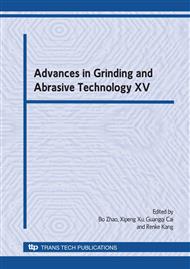p.519
p.524
p.529
p.535
p.540
p.546
p.553
p.558
p.563
Experimental Temperature Studies on Two Dimensional Ultrasonic Vibration Grinding the Nano-ZrO2 Ceramics
Abstract:
In processing of engineering ceramics materials with diamond grinding wheel, grinding heat is one of vital factors influencing workpiece surface quality. Grinding parameters have important influences on workpiece surface temperature distributions. Contrast experiments on grinding temperature of nanoZrO2 under common and two dimensional ultrasonic vibration grinding(TDUVG) were carried out in this paper by manual thermocouple method. The relationship between grinding parameters and grinding temperature was clarified through theoretical analysis and experiment confirmation. The research results show that with the increases of grinding depth, grinding speed, and decrease of working table speed, the workpiece’s surface temperature would heighten accordingly. Furthermore, comparing with high surface layer temperature in common grinding, which often results in grinding burn, TDUVG can reduce grinding temperature effectively.
Info:
Periodical:
Pages:
540-545
Citation:
Online since:
September 2009
Authors:
Price:
Сopyright:
© 2009 Trans Tech Publications Ltd. All Rights Reserved
Share:
Citation:


